CIRC
09
.:Light:.
.:Photo Resistors:.

(ARDX) .:Arduino Experimentation Kit:. (ARDX)
What We're Doing
Whilst getting input from a potentiometer can be useful for human controlled experiments, what do we use when we want an environmentally controlled experiment? We use exactly the same principles but instead of a potentiometer (twist based resistance) we use a photo resistor (light based resistance). The Arduino cannot directly sense resistance (it senses voltage) so we set up a voltage divider (http://ardx.org/VODI). The exact voltage at the sensing pin is calculable, but for our purposes (just sensing relative light) we can experiment with the values and see what works for us. A low resistance value will occur when the sensor is well lit while a high value will occur when it is in darkness.
The Circuit
The Parts
| CIRC-09 Breadboard Sheet x1 |
2 Pin Header x4 |
Photo-Resistor x1 |
Wire | ||||
| 10k Ohm Resistor Brown-Black-Black-Red x1 |
560 Ohm Resistor Green-Blue-Black-Black x1 |
Green LED x1 |
|||||
Schematic
Resources
.:download:.
Breadboard layout sheet
http://ardx.org/BBLS09
Fritzing diagram
https://wcrsyyc.github.io/ardx/fritzing/CIRC09.fzz
.:view:.
assembly video
http://ardx.org/VIDE09
Code (no need to type everything in just)
Download the Code from (
http://ardx.org/CODE09 )
(and then copy the text and paste it into an empty Arduino Sketch)
/*
* A simple program that will change the intensity of an LED based
* on the amount of light incident on the photo resistor.
*/
//PhotoResistor Pin
int lightPin = 0; //the analog pin the photoresistor is connected to
//LED Pin
int ledPin = 9; //the pin the LED is connected to
//we are controlling brightness so
//we use one of the PWM (pulse width
// modulation pins)
void setup()
{
pinMode(ledPin, OUTPUT); //sets the led pin to output
}
/*
* loop() - this function will start after setup
* finishes and then repeat
*/
void loop()
{
int lightLevel = analogRead(lightPin); //Read the light level
//the photoresistor is not calibrated to any units so
//this is simply a raw sensor value (relative light)
lightLevel = map(lightLevel, 0, 900, 0, 255);
//adjust the value 0 to 900 to
//span 0 to 255
lightLevel = constrain(lightLevel, 0, 255);//make sure the
//value is between
//0 and 255
analogWrite(ledPin, lightLevel); //write the value
}
Not Working? (3 things to try)
LED Remains Dark
This is a mistake we continue to make time and time again, if only they could make an LED that worked both ways. Pull it up and give it a twist.
It Isn't Responding to Changes in Light.
Given that the spacing of the wires on the photo-resistor is not standard, it is easy to misplace it. Double check it´s in the right place.
Still not quite working?
You may be in a room which is either too bright or dark. Try turning the lights on or off to see if this helps. Or if you have a flashlight nearby give that a try.
Making it Better?
Reverse the response:
Perhaps you would like the opposite response. Don't worry we can easily reverse this response just change:
analogWrite(ledPin, lightLevel); ----> analogWrite(ledPin, 255 - lightLevel);
Upload and watch the response change:
Night light:
Rather than controlling the brightness of the LED in response to light, lets instead turn it on or off based on a threshold value. Change the loop() code with.
void loop(){
int threshold = 300;
if(analogRead(lightPin) > threshold){
digitalWrite(ledPin, HIGH);
}else{
digitalWrite(ledPin, LOW);
}
}
Light controlled servo:
Lets use our newly found light sensing skills to control a servo (and at the same time engage in a little bit of Arduino code hacking). Wire up a servo connected to pin 9 (like in CIRC-04). Then open the Knob example program (the same one we used in CIRC-08) File > Examples > Library-Servo > Knob. Upload the code to your board and watch as it works unmodified.
Using the full range of your servo:
You'll notice that the servo will only operate over a limited portion of its range. This is because with the voltage dividing circuit we use the voltage on analog pin 0 will not range from 0 to 5 volts but instead between two lesser values (these values will change based on your setup). To fix this play with the val = map(val, 0, 1023, 0, 179); line. For hints on what to do visit http://arduino.cc/en/Reference/Map. HINT: It is also a good idea to make sure that the requested servo position stays in the valid range of 0 to 180. To combine that with the map function, you can use something like
val = constrain( map( val, 100, 900, 0, 180 ), 0, 180 );
to say that values of 100 to 900 will translate to angles from 0 to 180 degrees, but still keep in the valid range if the input value is less than 100 or greater than 900.